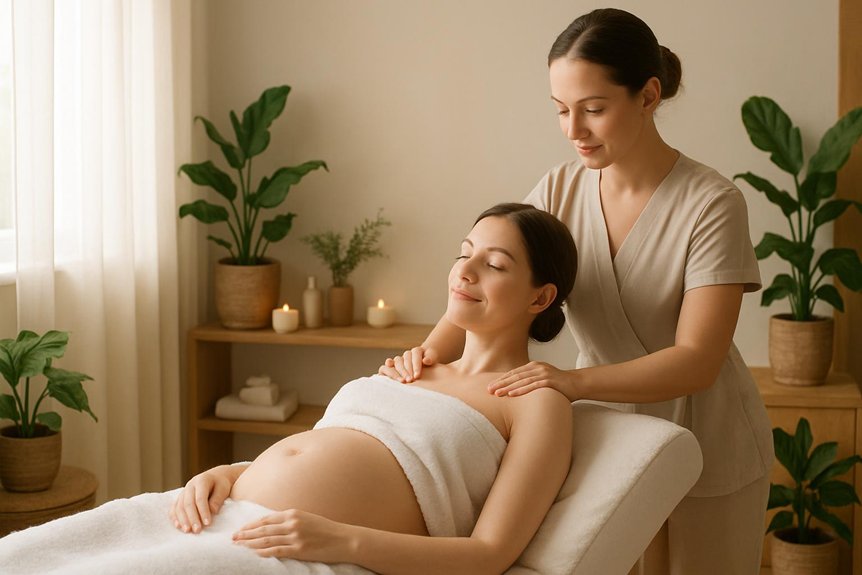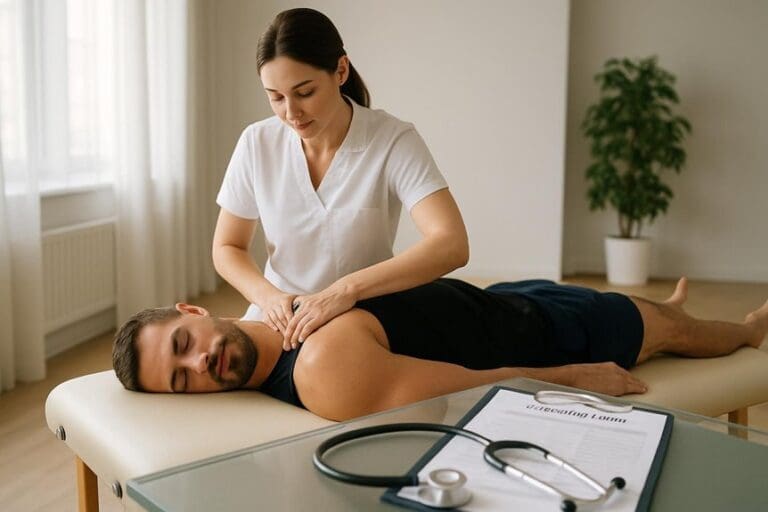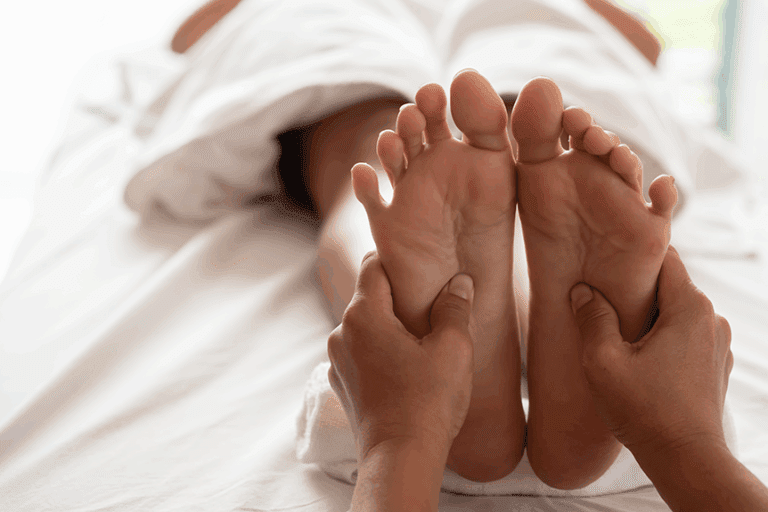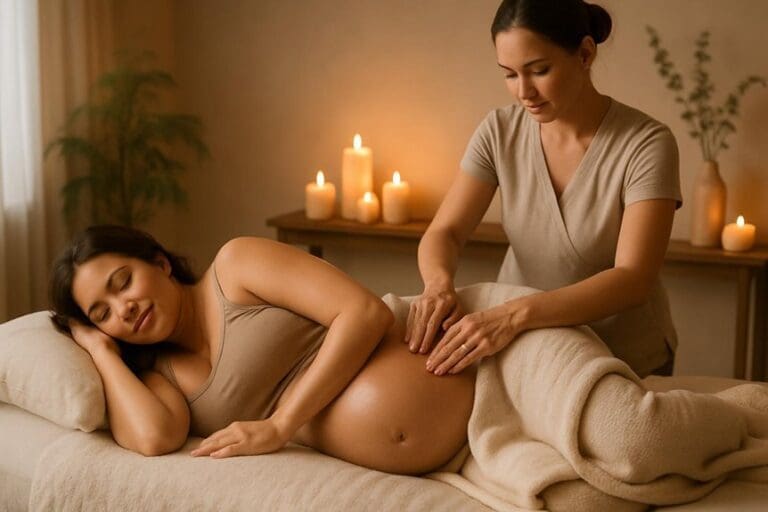Yes—when clinically screened and adapted, a full body massage in early pregnancy can be safe. A trained therapist uses light-to-moderate pressure, avoids deep abdominal or pelvic work, and positions the client side-lying or semi-reclined to reduce aortocaval compression. Neutral oils and brief, mild aromatherapy are preferred. Postpone if there is bleeding, severe abdominal pain, fever, faintness, uncontrolled vomiting, or calf pain/swelling. Hydration, rest, and gentle aftercare are advised. Further guidance explains benefits, positioning, and red flags.
What Early Pregnancy Means for Massage Eligibility

Although many individuals feel well enough to seek touch therapy in the first trimester, early pregnancy warrants a conservative approach to massage eligibility. A clinical screen should verify gestational age, baseline health, and current symptoms.
Spa & Massage therapists prioritise informed consent, gentle pacing, and adaptations aligned with early physiological shifts—fatigue, breast tenderness, queasiness, heightened scent sensitivity, and fluctuating blood pressure.
Eligibility focuses on comfort-led positioning and light-to-moderate pressure for relaxation rather than intensity. Techniques that invite soothing connection without overloading the system are preferred; in our clinics, therapists modulate rhythm, pressure, and session length to match energy and tolerance on the day.
Neutral, low-aroma oils are selected to minimise nausea triggers. Where uncertainty exists, therapists recommend liaising with the client’s primary maternity caregiver to harmonise care.
Some clients may also wish to explore complementary therapies like reflexology, which has been shown to promote relaxation and support general well-being during pregnancy.
Safety Considerations During the First Trimester
In the first trimester, careful screening and modified techniques are essential. This includes applying gentle pressure, positioning the client in side-lying or semi-reclined positions, and avoiding abdominal and deep pelvic work.
Contraindications include unexplained vaginal bleeding, severe nausea or vomiting, fever, recent miscarriage risk, severe abdominal pain, or a history of thromboembolic events. In these cases, massage should be deferred and medical guidance sought.
At Spa & Massage, therapists conduct a thorough health intake, watch for red flags such as dizziness, shortness of breath, or new calf pain/swelling, and adapt or postpone treatment to prioritise maternal and fetal safety.
First-Trimester Precautions
Why do first-trimester massage precautions matter? The first 12 weeks involve rapid embryonic development and heightened hormonal shifts; care must be calibrated to avoid undue pressure, overheating, or positional strain. Evidence supports gentle, symptom-led approaches.
At Spa & Massage, therapists prioritise side-lying or semi-reclined positioning, avoiding prolonged supine time once nausea or dizziness appears. Pressure remains light to moderate, steering clear of deep abdominal work and vigorous techniques.
They use neutral, hypoallergenic oils; aromatherapy is limited, avoiding potent stimulatory essential oils. Local heat is used cautiously; no full-body overheating.
Therapists screen for nausea, fatigue, spotting history, and migraine patterns, adjusting session length and tempo. Hydration, slow changes in position on and off the couch, and post-session rest are encouraged to preserve comfort, intimacy, and calm without escalating risk.
Contraindications and Red Flags
Several clear contraindications and red flags guide first‑trimester massage safety and should trigger deferral or medical clearance. Active vaginal bleeding, severe abdominal pain, suspected ectopic pregnancy, fever or systemic infection, uncontrolled vomiting with dehydration, new severe headache or visual changes, chest pain or shortness of breath, and signs of deep vein thrombosis (unilateral calf pain, heat, swelling) warrant postponement.
Hypertension not yet stabilised, placenta‑related bleeding, and a history of recurrent miscarriage also merit caution.
At Spa & Massage, therapists use pregnancy‑specific screening before every session. If any red flag appears, treatment is paused and the client is encouraged to contact a midwife or GP.
When cleared, gentle, side‑lying techniques and light pressure are preferred; abdominal work, deep gluteal pressure, and vigorous stretches are avoided.
Benefits of Gentle Massage in Early Pregnancy
Early pregnancy can be accompanied by musculoskeletal tension, sleep disruption, nausea, and anxiety. Gentle, appropriately modified massage may help alleviate these symptoms when delivered by trained practitioners.
Evidence suggests light-to-moderate pressure can reduce low back, pelvic, and neck discomfort by easing myofascial tightness and supporting postural changes. Parasympathetic activation may improve sleep quality and lower perceived stress.
For some, slow, rhythmic strokes lessen queasiness by reducing sympathetic arousal and promoting diaphragmatic breathing.
At Spa & Massage clinics in London, therapists use side-lying positioning, supportive bolsters, and neutral, hypoallergenic oils to enhance safety and comfort. Touch is kept focused and calm, avoiding deep abdominal work.
Sessions emphasise paced breathing, gentle limb mobilisations, and precise pressure dosing. Many clients report softer shoulders, steadier mood, and a kinder relationship with a changing body.
When to Avoid Massage and Seek Medical Advice
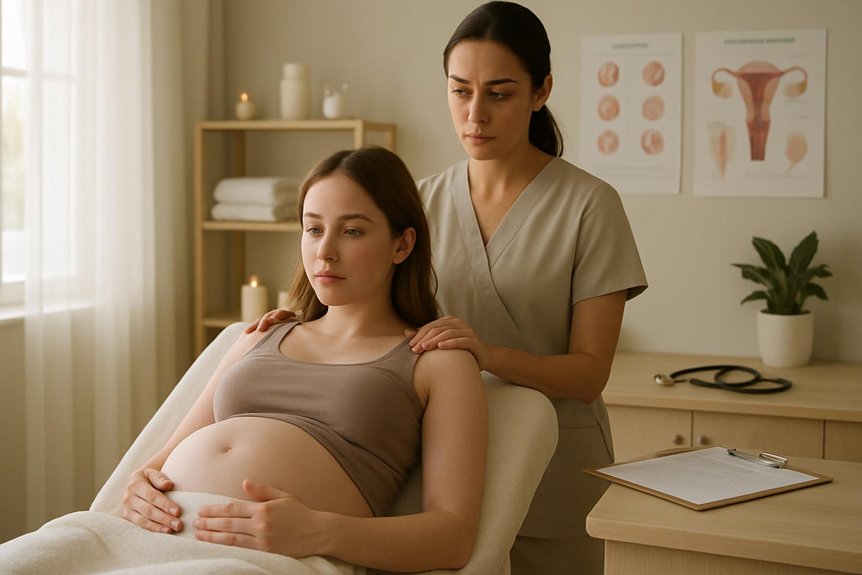
Spa & Massage advises that clients with high‑risk flags—such as a history of miscarriage, placenta previa, preeclampsia, uncontrolled hypertension, severe anemia, or multiple gestation—should obtain clinician clearance before booking.
Acute symptoms including vaginal bleeding, abdominal pain, fluid leakage, severe headache, visual changes, chest pain, shortness of breath, calf pain/swelling, fever, or reduced fetal movement warrant medical assessment prior to massage.
Sessions should also be postponed during active infections, gastrointestinal illness, new injuries, or until 24–48 hours after significant medical procedures or medication changes, in line with our safety protocols.
High-Risk Pregnancy Flags
A cautious approach is essential when considering massage in pregnancy, as certain clinical red flags warrant deferral and medical assessment.
High‑risk indicators include a history of recurrent miscarriage, current vaginal bleeding, suspected ectopic or molar pregnancy, severe abdominal pain, placenta‑related disorders, hypertensive disease (including pre‑eclampsia), poorly controlled diabetes or thyroid disease, clotting disorders or anticoagulant therapy, significant anaemia, fever or systemic infection, and recent trauma or surgery.
Multiple pregnancy with complications, reduced fetal growth, or prior preterm birth also elevate risk.
Where these factors are present, massage should be postponed until a clinician confirms safety parameters.
At Spa & Massage, therapists screen discreetly, adapt positioning and pressure only within medical guidance, and will recommend medical review when indicated—prioritising maternal reassurance, circulation comfort, and fetal wellbeing above all.
Symptoms Needing Clearance
When should massage be deferred in early pregnancy? Massage should pause and medical advice be sought if there is vaginal bleeding or spotting, new pelvic pain or cramping, persistent unilateral abdominal pain, or suspected ectopic pregnancy.
Other red flags include severe nausea with dehydration, fever, dizziness or fainting, severe headache, visual changes, chest pain, shortness of breath, calf pain or swelling (possible DVT), reduced or absent fetal movements after they have begun, sudden swelling of face/hands, or right‑upper‑quadrant pain.
At Spa & Massage, therapists screen gently and discreetly. If any concerning symptom is disclosed, they do not proceed and advise contacting a midwife, GP, or urgent care service.
With written clearance, sessions can be adapted—avoiding deep pressure, maintaining side‑lying positioning, and prioritising comfort, safety, and calm.
When to Postpone Massage
Occasionally, deferral is the safest course. In early pregnancy, massage should be postponed if there is vaginal bleeding, severe abdominal pain or cramping, fever, suspected infection, dizziness or fainting, new severe headache, visual changes, shortness of breath at rest, calf pain or swelling, chest pain, reduced fetal movements after quickening, or if advised bed rest.
Those with placenta previa, cervical insufficiency, preeclampsia, uncontrolled thyroid disease, clotting disorders, or recent trauma should seek medical guidance first.
At Spa & Massage, therapists screen gently but thoroughly and will reschedule if red flags appear. Clients are encouraged to share every change, however small.
With clinician clearance, care resumes using side-lying positioning, light-to-moderate pressure, unscented or hypoallergenic oils, and close monitoring—prioritising maternal comfort, circulation, and calm.
How Our Therapists Adapt Techniques for the First Trimester
Though early pregnancy is typically low risk, Spa & Massage therapists modify every session in the first trimester to prioritise maternal comfort and fetal safety. They begin with a detailed health screen, noting nausea, fatigue, bleeding risk, IVF, and prior loss.
Pressure is kept light-to-moderate, avoiding deep, sustained compressions over the abdomen, inner thighs, and known acupressure points linked to uterine activity. Strokes are slower and rhythmic to support relaxation without overstimulation.
Therapists emphasise lymphatic-style techniques for fluid shifts, gentle myofascial work for chest and upper back tension, and careful mobilisation for neck and shoulders.
In our clinics, unscented or low-allergen carrier oils are used; potential emetogenic essential oils are deferred. Temperature, pacing, and therapist communication remain calm and unhurried, with frequent consent checks to honour changing sensations.
Positions and Support Cushions for Comfortable Treatment
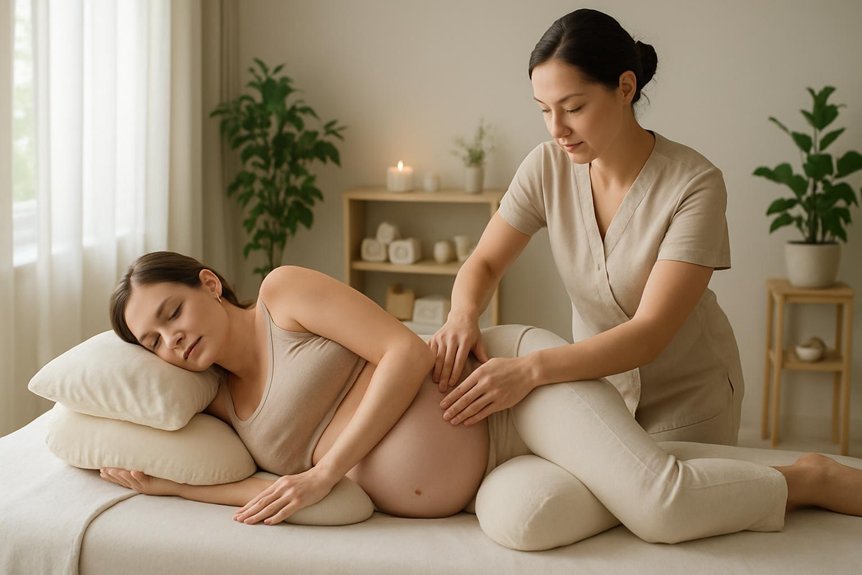
Building on the adapted techniques of the first trimester, positioning is selected to minimise aortocaval compression, nausea, and ligament strain while maintaining access for safe, effective work.
Side‑lying is preferred after six weeks, with the upper hip and knee flexed and supported to keep the lumbar spine neutral and the pelvis quiet. A slim wedge elevates the torso 15–30 degrees when supine rest is desired, reducing reflux and breathlessness; prolonged flat supine is avoided.
At Spa & Massage, therapists use pregnancy‑specific bolsters, adjustable wedges, and soft chest supports to cradle the breasts and abdomen without pressure. Small cushions under the abdomen and between the knees promote sacroiliac ease.
Prone positioning on standard tables is avoided; brief prone work occurs only with verified, well‑fitted pregnancy bolsters and continuous feedback.
Oils and Aromatherapy Choices We Use Safely in Pregnancy
While scent can enhance relaxation, product selection in early pregnancy prioritises safety, low sensitisation risk, and minimal systemic exposure.
At Spa & Massage, therapists favour neutral, hypoallergenic carriers such as fractionated coconut, grapeseed, or sunflower oil, used sparingly to maintain glide without occlusion.
Essential oils, if requested, are limited to low dilutions (typically ≤0.5%) after screening for allergies and preferences.
Evidence-informed choices include lavender (true), mandarin, or Roman chamomile—oils with gentler safety profiles—while contraindicated or higher-risk oils (e.g., clary sage, jasmine, rosemary, cinnamon) are avoided in early pregnancy.
Diffusion, when used, is brief and minimal.
Patch testing is performed when history suggests sensitivity.
Clients may opt for unscented sessions.
Therapists document selections, monitor comfort, and adjust promptly to preserve calm, intimate ease with clinical caution.
What to Expect at Your First Pregnancy Massage With Us
A first prenatal massage at Spa & Massage begins with a brief, confidential consultation to confirm gestational age, medical history, current symptoms, and any contraindications.
The therapist clarifies goals—relief of back, hip, or pelvic tension; reduced nausea; improved sleep—and explains positioning. In early pregnancy, side-lying and semi‑reclined setups are used, with pillows to support the abdomen, pelvis, and knees, maintaining airway ease and venous return.
Pressure is moderate, avoiding deep work over the abdomen, inner thighs, and known trigger points. Strokes are slow and rhythmic to enhance parasympathetic tone.
In our clinics, neutral, hypoallergenic oils are used; aromatics are added only when clinically appropriate. Communication is encouraged—any warmth, dizziness, or discomfort prompts immediate adjustment.
Sessions typically last 45–60 minutes, accommodating energy levels and privacy needs.
Aftercare Tips and Signs to Monitor Post-Massage
Following a prenatal massage, Spa & Massage advises simple, evidence-informed aftercare to support comfort and safety: hydrate with water, rise slowly to reduce orthostatic dizziness, and schedule light activity rather than strenuous exercise for 12–24 hours.
Their therapists suggest a warm (not hot) shower, gentle stretching, and small, regular meals to stabilise energy.
In clinic, unscented or pregnancy-safe oils are used; if skin is sensitive, clients may prefer rinsing within a few hours.
They recommend monitoring for expected responses—mild sleepiness, soft muscle soreness—and prioritising rest.
Seek medical advice promptly if any red flags occur: vaginal bleeding, fluid loss, new pelvic or abdominal pain, persistent headache, visual changes, calf swelling or pain, chest tightness, shortness of breath, reduced fetal movements, fever, or an allergic skin reaction.
Conclusion
In early pregnancy, a full body massage can be cautiously embraced—never as a cure-all, but as a meticulously calibrated comfort. With conservative pressure, strategic positioning, and evidence-informed screening, benefits can be significant: eased tension, improved sleep, steadier mood. Yet red flags—severe nausea, cramping, bleeding, fever, or clotting risks—demand medical clearance faster than a racing pulse. Spa & Massage’s therapists adapt with almost obsessive precision—bolsters aligned, scents minimal, aftercare clear—so safety isn’t guessed; it’s engineered.
